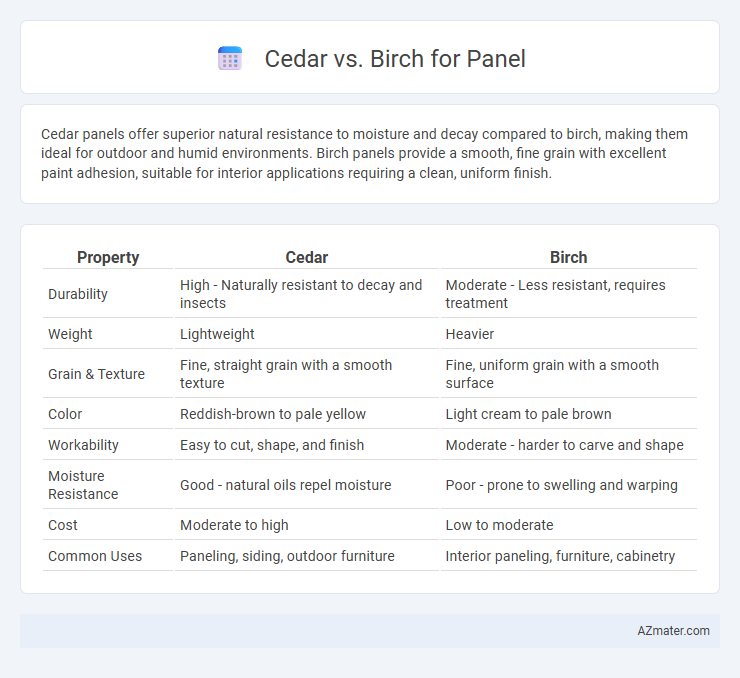Cedar panels offer superior natural resistance to moisture and decay compared to birch, making them ideal for outdoor and humid environments. Birch panels provide a smooth, fine grain with excellent paint adhesion, suitable for interior applications requiring a clean, uniform finish.
Table of Comparison
| Property | Cedar | Birch |
|---|---|---|
| Durability | High - Naturally resistant to decay and insects | Moderate - Less resistant, requires treatment |
| Weight | Lightweight | Heavier |
| Grain & Texture | Fine, straight grain with a smooth texture | Fine, uniform grain with a smooth surface |
| Color | Reddish-brown to pale yellow | Light cream to pale brown |
| Workability | Easy to cut, shape, and finish | Moderate - harder to carve and shape |
| Moisture Resistance | Good - natural oils repel moisture | Poor - prone to swelling and warping |
| Cost | Moderate to high | Low to moderate |
| Common Uses | Paneling, siding, outdoor furniture | Interior paneling, furniture, cabinetry |
Overview of Cedar and Birch Paneling
Cedar paneling is prized for its natural resistance to moisture, decay, and insect damage, making it ideal for both interior and exterior applications. Birch paneling offers a smooth, fine grain and a pale color, which provides a clean, modern aesthetic and a durable surface suitable for high-traffic areas. Both woods vary in hardness and maintenance requirements, with cedar being softer and more aromatic, while birch demands more finishing to prevent yellowing and wear over time.
Key Differences Between Cedar and Birch Wood
Cedar wood is known for its natural resistance to moisture, decay, and insect damage, making it ideal for exterior and humid environments, while birch wood offers a smoother texture and fine grain that is preferred for interior panels and furniture due to its uniform appearance. Cedar tends to have a distinctive aromatic scent and reddish color, whereas birch is typically light-colored with subtle, cream to pale brown hues. Durability-wise, cedar is softer and less dense compared to birch, which is harder and more wear-resistant, influencing the choice based on application requirements.
Appearance and Grain Characteristics
Cedar panels exhibit a rich reddish-brown hue with a distinct, fine, and straight grain pattern that emphasizes warmth and natural elegance in interior design. Birch panels, by contrast, present a lighter cream to pale yellow color with a uniform, smooth grain featuring subtle waves or curls, offering a clean and contemporary aesthetic. The choice between cedar and birch panels hinges on the desired visual impact, with cedar providing rustic charm and birch delivering a sleek, minimalist look.
Durability and Longevity
Cedar panels offer superior durability due to natural oils that resist decay, insects, and moisture, making them ideal for exterior applications with a lifespan of 15-30 years. Birch panels, while providing a smooth and attractive finish, are less resistant to moisture and pests, resulting in shorter longevity typically around 10-15 years without proper treatment. Choosing cedar enhances long-term performance and reduces maintenance costs compared to birch in paneling projects.
Resistance to Moisture and Decay
Cedar is highly resistant to moisture and decay due to its natural oils and tight grain, making it ideal for paneling in humid or outdoor environments. Birch, while attractive and sturdy, is less resistant to moisture and prone to warping or fungal decay without proper sealing or treatment. Choosing cedar panels enhances durability and longevity in moisture-prone applications, whereas birch requires more maintenance to prevent deterioration.
Workability and Ease of Installation
Cedar offers superior workability due to its light weight and straight grain, making it easier to cut, shape, and fasten during panel installation compared to birch. Birch, being denser and harder, requires more precise handling and sharper tools, which can slow down the installation process. The natural resistance of cedar to warping and splitting further enhances ease of installation by reducing adjustment time on-site.
Environmental Impact and Sustainability
Cedar panels are known for their natural resistance to decay and insects, reducing the need for chemical treatments, which enhances their environmental sustainability. Birch panels, often sourced from fast-growing hardwood forests, offer a renewable option but typically require more intensive processing, leading to a higher carbon footprint. Choosing cedar supports long-lasting durability with lower maintenance, while birch provides a sustainable resource when harvested responsibly from well-managed forests.
Cost Comparison of Cedar vs Birch Panels
Cedar panels typically cost between $4 and $7 per square foot, offering a mid-range price point with natural resistance to moisture and decay, making them ideal for exterior applications. Birch panels, priced around $3 to $5 per square foot, are more affordable but require additional treatment to enhance durability, especially in humid conditions. The cost difference reflects Cedar's premium durability and aesthetic appeal versus Birch's cost-effectiveness and versatility in interior paneling projects.
Ideal Applications for Each Wood Type
Cedar is ideal for outdoor paneling and siding due to its natural resistance to moisture, decay, and insect damage, making it perfect for decks, garden structures, and exterior walls. Birch, with its smooth grain and light color, is best suited for indoor panels, cabinetry, and furniture where a clean, modern aesthetic is desired and durability under moderate wear is needed. Both woods offer unique benefits, with cedar excelling in weather-exposed environments and birch providing a refined finish for interior applications.
Choosing the Right Wood: Cedar or Birch?
Choosing between cedar and birch for paneling depends on durability, appearance, and maintenance needs. Cedar offers natural resistance to moisture and insects, making it ideal for humid environments, while birch provides a smooth, fine grain with a light color perfect for painted finishes and modern interiors. Cost-wise, birch is generally more affordable, whereas cedar's aromatic properties and longevity make it a premium option for long-term projects.

Infographic: Cedar vs Birch for Panel
 azmater.com
azmater.com